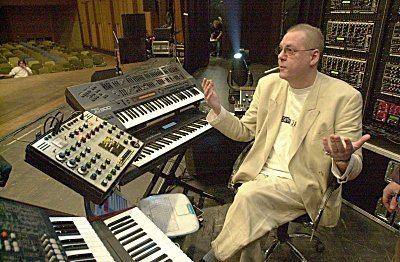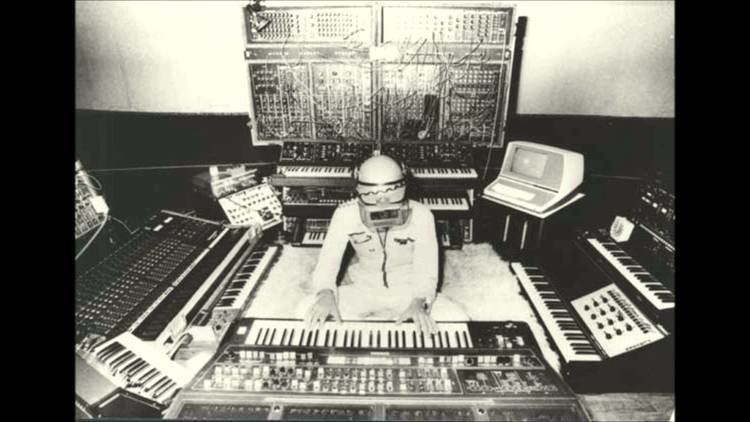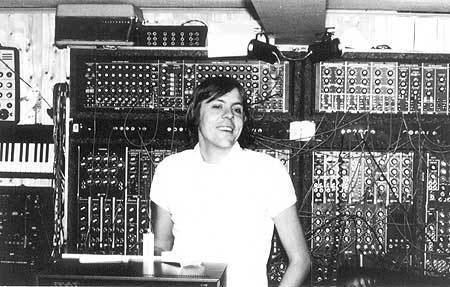Occupation(s) Musician, Producer | Years active 1969–present Name Klaus Schulze | |
 | ||
Born 4 August 1947 (age 78) ( 1947-08-04 ) Instruments Keyboards, synthesiser, sequencer, guitar, bass, drums, percussion, vocals Labels OhrBrain/PolyGram RecordsVirgin RecordsMetronomeManikin RecordsIsland RecordsICInteamZYX RecordsWEARainhorseSynthetic SymphonyFAX +49-69/450464 Role Musical composer · klaus-schulze.com Movies Kraftwerk and the Electronic Revolution Albums Profiles | ||
Klaus Schulze - Psychedelic journey
Klaus Schulze (born 4 August 1947) is a German electronic music composer and musician. He also used the alias Richard Wahnfried. He was briefly a member of the electronic bands Tangerine Dream and Ash Ra Tempel before launching a solo career consisting of more than 60 albums released across five decades.
Contents
- Klaus Schulze Psychedelic journey
- Schiller zenit with klaus schulze
- 1970s
- 1980s
- 1990s
- 2000s
- 2010s
- Richard Wahnfried
- Albums
- Richard Wahnfried albums
- Boxed sets
- The Dark Side of the Moog series
- Promos
- Compilations
- Lone tracks
- References

Schiller zenit with klaus schulze
1970s

In 1969, Klaus Schulze was the drummer of one of the early incarnations of Tangerine Dream for their debut album Electronic Meditation. Before 1969 he was a drummer in a band called Psy Free. He met Edgar Froese from Tangerine Dream in the Zodiac Club in Berlin in that time West-Germany. In 1970 he left this group to form Ash Ra Tempel with Manuel Göttsching and Hartmut Enke. In 1971, he chose again to leave a newly formed group after only one album, this time to mount a solo career. In 1972, Schulze released his debut album Irrlicht with organ and a recording of an orchestra filtered almost beyond recognition. Despite the lack of synthesizers, this proto-ambient work is regarded as a milestone in electronic music. The follow-up, Cyborg, was similar but added the EMS Synthi A synthesiser.

Since this point, Schulze's career has been most prolific, and he can now claim more than 40 original albums to his name since Irrlicht. Highlights of these include 1975's Timewind, 1976's Moondawn (his first album to feature the Moog synthesiser), 1979's Dune, and 1995's double-album In Blue (which featured one long track called Return To The Tempel with electric guitar contributions from his friend Manuel Göttsching of Ash Ra Tempel). In 1976, he was drafted by Japanese percussionist and composer Stomu Yamashta to join his short-lived "supergroup" Go, also featuring Steve Winwood, Michael Shrieve, and Al Di Meola. They released two studio albums (Go in 1976 and Go Too in 1977) and one live album ("Live from Paris", 1976), which went on to become a cult favourite.

Throughout the 1970s he followed closely in the footsteps of Tangerine Dream, albeit with far lighter sequencer lines and a more reflective, dreamy sheen, not unlike the ambient music of his contemporary Brian Eno. On occasions he would also compose film scores, including horror and thriller movies such as Barracuda (1978) and Next of Kin (1982). It is to be noted that some of his lighter albums are appreciated by new-age music fans, despite the fact that Schulze has always denied connections to this genre. By mid-decade, with the release of Timewind and Moondawn, his style transformed from Krautrock to Berlin School.
Klaus Schulze had a more organic sound than other electronic artists of the time. Often he would throw in decidedly non-electronic sounds such as acoustic guitar and a male operatic voice in Blackdance, or a cello in Dune (1979) and Trancefer. Schulze developed a Minimoog technique that sounds uncannily like an electric guitar, which is quite impressive in concert. Schulze often takes German events as a starting point for his compositions, a notable example being on his 1978 album "X" (the title signifying it was his tenth album), subtitled "Six Musical Biographies", a reference to such notables as Ludwig II of Bavaria, Friedrich Nietzsche, Georg Trakl, and Wilhelm Friedemann Bach. His use of the pseudonym Richard Wahnfried is indicative of his interest in Richard Wagner, a clear influence on some albums like the aforementioned Timewind.
1980s
In the 1980s Schulze started using digital instruments besides the usual analog synthesizers, and his work accordingly became less experimental and more accessible. Although the switch to using digital equipment is audible in the style of Dig It (1980), it was not until the release of Trancefer (1981) that the shift in style became evident. Trancefer was far more obviously reliant on sequencers than previous recordings, and the resultant effect transformed Schulze's style from gentle melodic journeys to an ever-growing crescendo of music consisting of multi-layered rhythmical passages. This is particularly noteworthy in the Trancefer's first track "A Few Minutes After Trancefer", although the second track "Silent Running" is more reminiscent of Schulze's earlier works.
This newer style can also be found in Schulze's next release Audentity. Both "Cellistica" and "Spielglocken" are composed in a similar, sequencer based, style as Trancefer, but this is certainly not the case of all of Audentity's tracks, indeed "Sebastian im Traum" hints towards the Operatic style to be found in some of Schulze's much later work. The predominance of sequencing can also be found in the follow-up live album Dziękuję Poland Live '83, although it should be noted that many of its tracks are re-workings of those to be found on Audentity. Schulze's next studio-based album Angst (soundtrack to the namesake 1983 film) moved away from the harshness of sharp, heavily sequenced style of the 3 previous albums and, once again, had the more "organic feel" of earlier recordings.
Another highlight of this era was En=Trance with the dreamy cut "Fm Delight". The album Miditerranean Pads marked the beginning of very complex percussion arrangements that continued into the next two decades.
In 1989, German band Alphaville released their album The Breathtaking Blue, on which Klaus Schulze was both a contributing musician (partially) and the album's producer.
1990s
Starting with Beyond Recall, the first half of the 1990s was the notorious "sample" period, when Schulze used a wide variety of pre-recorded sounds such as screeching birds and sensuous female moans in his studio albums and live performances. Sampling was such an unpopular diversion that when In Blue was released in 1995 without samples it was hailed as a return to form. The decade also saw the release of copious amounts of previously unreleased material, of varying quality, in several limited-edition boxed sets. Some live recordings were discovered on pristine but forgotten reels of tape which had been used to provide echo in concerts.
2000s
In 2005 he began re-releasing his classic solo and Wahnfried albums with bonus tracks of unreleased material recorded at roughly the same time as the original works. In the last several years, Schulze has produced albums and staged numerous live appearances with Lisa Gerrard.
2010s
With the release of his fortieth album (Big in Japan: Live in Tokyo 2010) in September 2010, Klaus Schulze entered his fifth decade as a solo musician. His next album, Shadowlands, was released in February 2013, quickly to be followed by the release of The Schulze–Schickert Session 1975, a rare long-unreleased collaboration, in March 2013.
Also in 2013 Klaus Schulze announced that he would not be performing live on stage anymore.
Richard Wahnfried
Richard Wahnfried, then simply Wahnfried after 1993, is the long-time and only real alias for Klaus Schulze – originally a pseudonym, later an official side project name. Seven albums were released under this name between 1979 and 1997.
The main characteristics of the Wahnfried albums (as opposed to Schulze's regular works) are:
The pseudonym's etymology stems from Schulze's love for Richard Wagner:
In his 1975 album Timewind (four years before the first alias use), Schulze had already named a track "Wahnfried 1883" (in reference to Wagner's death and burial in his Wahnfried's garden in 1883). The other track on Timewind is called "Bayreuth Return". After 1993, the albums are simply credited to "Wahnfried", and namedrop Schulze ("featuring Klaus Schulze", "Produced by Klaus Schulze").
"Wahnfried" is the only known alias of Schulze (albeit on the 1998 Tribute to Klaus Schulze album, among 10 other artists, Schulze contributed one track barely hidden behind the "Schulzendorfer Groove Orchester" pseudonym).
Albums
Schulze's concert performances are original compositions recorded live and thus listed as albums. An intensive reissue program of Schulze CDs began in 2005, with most releases having bonus tracks, and sometimes additional discs. They are published by the label Revisited Records (a division of German company InsideOut Music 1), and distributed by SPV.
(Richard) Wahnfried albums
Composed by Schulze and performed with guest artists under alias Richard Wahnfried or later just Wahnfried:
Boxed sets
Between 1993 and 2002 Klaus Schulze released several limited edition boxed sets, all composed of non-album material.
The Dark Side of the Moog series
The Dark Side of the Moog is a Klaus Schulze collaboration with Pete Namlook, (joined also by Bill Laswell on volumes 4 to 7). Each title is a distortion of Pink Floyd song and album titles.
The Evolution of the Dark Side of the Moog is a compilation album, containing excerpts from the first 8 volumes. The series was announced as officially concluded with volume 10 when on 21 March 2005 at 14:52 CET, Pete Namlook sold the Big Moog synthesizer that was the symbol of the series. However, a volume 11 appeared on Namlook's website on 15 April 2008.
Promos
Compilations
Lone tracks
This list includes only the tracks remaining uncollected after Lone Tracks (CD 50 of The Ultimate Edition) and La Vie Electronique volumes.
